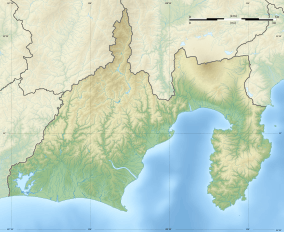Nirayama Daikansho
The Nirayama daikansho (韮山代官所) was an Edo period government administrative center for the tenryō territories in eastern Japan during the direct control of the Tokugawa shogunate. It was located in what is now part of the city of Izunokuni, Shizuoka in the Tōkai region of Japan. There were once many daikansho located in various parts of Japan serving a similar function, and this is one of the few which remains in relatively intact. It was designated a National Historic Site of Japan in 2004.[1]
韮山代官所 | |
 Nirayama daikansho | |
 Nirayama daikansho  Nirayama Daikansho (Japan) | |
| Location | Izunokuni, Shizuoka, Japan |
|---|---|
| Region | Tōkai region |
| Coordinates | 35°3′16.6″N 138°57′33.2″E |
| History | |
| Founded | Edo period |
| Site notes | |
| Ownership | National Historic Site |
| Public access | Yes |
Overview
The Nirayama daikansho administrated all of Izu Province (which was completely tenryō territory), as well as large portions of Suruga, Sagama and Musashi Provinces, as well as a portion of Kai Province and the Izu islands. Its kokudaka fluctuated at several points in its history, but was estimated to be at around 50,000 to 100,000 koku. The Niiraya daikansho was headed by a hereditary daikan, equivalent to a hatamoto from the Egawa clan (except for a period from 1723-1758). The head of this clan always took the name of Egawa Tarō Uzaemon. The Egawa were a samurai clan who claimed descent from the Seiwa Genji who controlled central Izu since the Heian period. Similar to the daimyō, they also maintained a residence in Edo (located in Honjō). However, unlike the daimyō, they were not subject to sankin kōtai, but alternated residence between Edo in summer and Nirayama in winter. As the shogunal territories under their administration were scattered across a wide area, secondary offices were established at various locations for administrative and tax collection purposes..
In 1596, Tokugwa Ieyasu appointed Egawa Hidenaga (1560-1639) as daikan of half of Izu Province, with the remainder under the Mishima daikansho. The two offices were united to form the Niirayama daikansho in 1633. However, in 1723, Egawa Hidekatsu was found guilty of embezzling public funds intended for repairs to the Tōkaidō at Totsuka and was relieved of his office. The clan regained the post in 1758; however, its scope of authority after this date was limited only to Izu Province, which it continued to govern until the Meiji restoration.
Important Cultural Properties
The Egawa residence complex was designated an Important Cultural Property on May 14, 1958. Attached buildings such as gates and gardens were added to the collective designation from December 9, 1993.
Egawa house complex (7 buildings)
- 12,302.46 square meters of landscaping grounds, including ponds and wells
Documents
- Construction drawings and records of repairs
- Daiskansho records (33,663 items)
- Printed Books (430 volumes)
- Chinese/Japanese Books (3507 volumes)
- Translated documents (366 items)
- Foreign Books (144 volumes)
- Calligraphy Books (142 volumes)
- old Photographs (461 items)
Other
- Weapons and armor (41 items)
- Boxes and containers (288 items)
 Floor of Egawa residence
Floor of Egawa residence North and South Rice Warehouses
North and South Rice Warehouses Egawa residence
Egawa residence Ferttilizer Warehouse
Ferttilizer Warehouse Front Gate
Front Gate
References
- "韮山役所跡" (in Japanese). Agency for Cultural Affairs.
External links
| Wikimedia Commons has media related to Egawa-tei. |
- Official home page
- Izunokuni city home page (in Japanese)